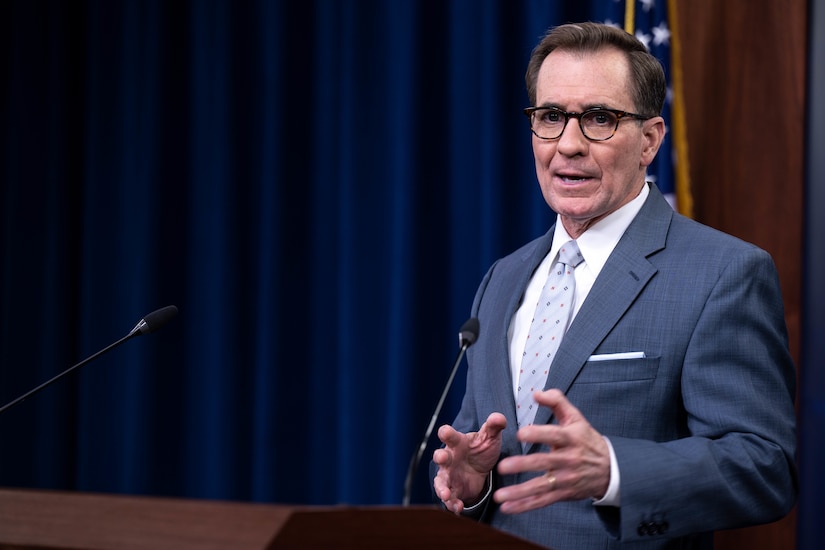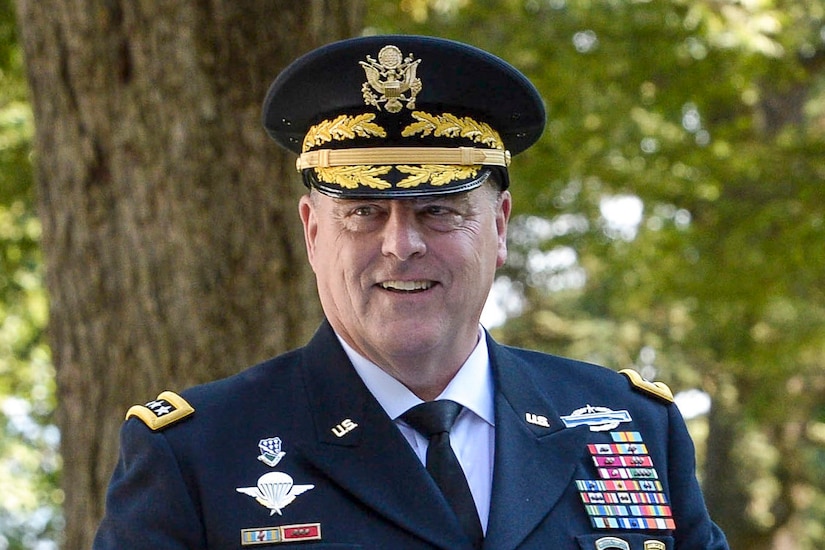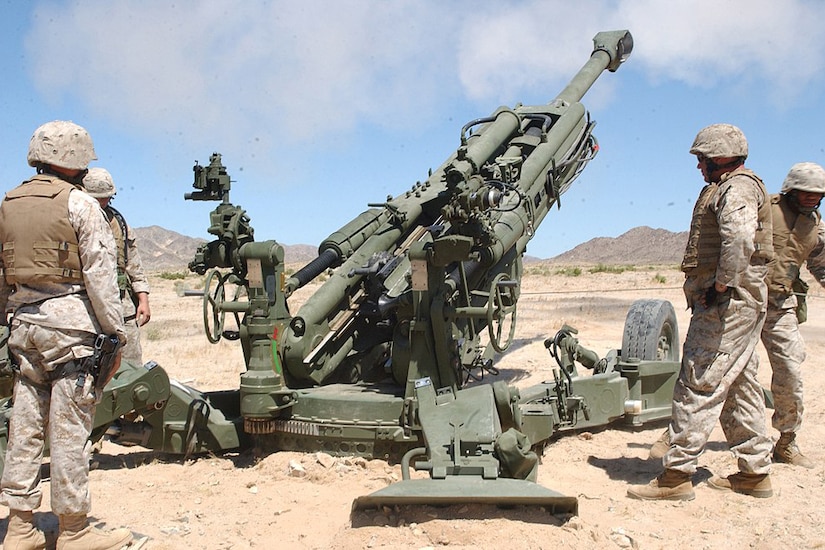View Online
Pentagon Press Secretary John F. Kirby Holds a Press Briefing
April 29, 2022
PRESS SECRETARY JOHN F. KIRBY: Good afternoon. Normally, I get a “good afternoon” back, but I guess we’re all tired.
(CROSSTALK)
MR. KIRBY: Yeah, yeah. All right. I have a couple things at the top today.
Today, I can announce that the United States has commenced training with the Ukrainian Armed Forces on key systems at U.S. military installations in Germany. Now, these efforts build on the initial artillery training that Ukraine’s forces already have received elsewhere, and also includes training on the radar systems and armored vehicles that have been recently announced as part of security assistance packages. U.S. Army Europe and Africa Command will organize this training in coordination with the government of the Federal Republic of Germany, and we’re grateful, of course, for Germany’s continued support.
As you recall, in February, out of an abundance of caution, the secretary ordered the temporary repositioning of about 160 members of the Florida National Guard who were then supporting the Joint Multinational Training Group Ukraine, and we said at the time that this decision was not the end of the — our relationship with Ukraine, of course and with that, we would explore new ways to work together in the future. The recent reunion now of these Florida National Guard members with their Ukrainian colleagues, we are told, was an emotional meeting, given the strong bonds that were formed as they were living and working together before temporarily parting ways in — in February.
Now, this new training effort in Germany and at other locations in Europe is in direct support of recent U.S. security assistance packages that are designed to help Ukraine win their battles today and build strength for tomorrow. These new systems and the associated training that will strengthen Ukraine’s ability to counter Russia’s renewed offensive in Eastern Ukraine. Since 2021, the United States has committed more than $4.3 billion in security assistance to support Ukraine’s Armed Forces in the face of Russian aggression, and as I have said before, we should not forget the importance of this long-term training relationship.
Now we’re — yet today, we’re talking about the Florida National Guard, but as you all know better than me, they were preceded by others of their colleagues going back over the last eight years. And so while we are rightly focused on the security assistance that’s going into Ukraine, we shouldn’t forget that a big part of Ukraine’s soldiers’ ability to defend the country as well as they have has been the training that they have gotten over the past eight years that have really sort — sort of helped transform them off of Soviet doctrine and — and Soviet area organization. They are — they have better command and control. They have better battlefield initiative. They have a competent noncommissioned officer corps that is empowered on the field of battle to make tactical decisions. That didn’t happen by accident, and so we’re grateful to be able to at least start some of this training on these key systems that are going forward and — and to keep improving their battlefield competence.
Now, I also have a couple of other schedule items to brief you. The Japanese Defense Minister Kishi will travel to the United States from May 3rd to the 6th, and he’ll have a chance to meet with Secretary Austin on the 4th of May. Items on the agenda, of course, include Ukraine. We were grateful that Japan was represented in that 40-plus meeting, that consultative meeting in Ramstein earlier this week. They’ll talk about China, of course, North Korea and defense cooperation initiatives to strengthen the deterrence and response capabilities of the Japan-U.S. alliance. Kishi will also have a chance to visit the Missile Defense Agency and U.S. Cyber Command to exchange views on ballistic missile defense and cyber cooperation.
And then lastly, on Wednesday, the 25th of May, Secretary Austin will travel to Colorado Springs to deliver the commencement address at the Air Force Academy this year. He’s very excited to get this opportunity to speak to the cadets as they begin brand-new careers as officers in the United States Air Force.
And with that, questions. Lita?
Q: … John. Can you flesh out the training decision a little more? Is — this is the same unit that was pulled out largely, other than maybe onesies, twosies that that might have swapped. But this is essentially the same unit that got pulled out of Ukraine?
MR. KIRBY: That’s correct, yeah.
Q: OK.
MR. KIRBY: They — they did not leave Europe. Yeah.
Q: And then are they doing the bulk of the training, or are they being supplemented by other U.S. forces on some of the other training?
MR. KIRBY: My — my — my under…
Q: In multiple locations, or is it consolidated? Can you give us a — a
MR. KIRBY: Sure. My understanding is the bulk of the training on these new systems will be done by the Florida National Guard, but I don’t want to preclude the — the — the option that on — on — on systems coming in that — that we might provide additional training capabilities that maybe the Florida National Guard doesn’t have, so — they’re do the bulk of it, but I’m not going to go so far as to say that all of the training will be done just by the Florida National Guard.
And what I can tell you is that we’re talking about roughly three locations outside of — of Ukraine, and in this case, we — we definitely can identify Germany as a site, but there are other sites outside Ukraine, and — and we’re just not at liberty to disclose where they are. Those sites could change over time. Either — either we move to different ones, or we add additional ones. We just don’t know, but — but training has already occurred outside Ukraine, and particularly on the howitzers. There’s another class going on right now on howitzers. In fact, two different tranches are being trained on howitzers right — right now. One of them, we can confirm, is in — is in Germany.
So we want to make this as nimble and as agile as we can, and we also want to make it not only useful and constructive for the Ukrainians, but not onerous, you know, that it doesn’t — that it’s not so time-consuming that it takes them out of their fight for — for too long, as you might imagine. These — these soldiers are — they’re eager to learn these new skills, but they’re also eager to apply those new skills in the conflict.
Q: And just one clarification: Has that Florida unit then extended, as — as we know some have not been redeployed?
MR. KIRBY: There has been no extension decision made on the — the — the Florida National Guard. As you might recall, Lita, they — they arrived in Ukraine at the very tail end of last year, early December-ish, so they are still on their original set of orders.
Travis?
Q: Hi, John. Happy Friday. I wanted to ask you about the former Marine who was killed in Ukraine, Willy Joseph Cancel. I hope I’m pronouncing his name correctly. But he was reportedly employed by a military contractor. Was that company contracted with the Department of Defense?
MR. KIRBY: Not that I’m aware of.
Q: Does the Department of Defense have any contractors working in Ukraine?
MR. KIRBY: Not that I’m aware of.
Yeah, Jen ?
Q: John, can you enumerate any more of the donations that came out of the conference earlier this week with the 40 nations? Is there anything else concrete that you can point to?
MR. KIRBY: There — there were some additional contributions but those nations have — have decided that it — it — it’s best for — for them to either talk about it or not, and so we want to respect that. I mean, the Secretary, at his press conference, afterward detailed what — what he could.
And again, these are sovereign decisions that we want to be respectful — but the bottom line is yes, there were additional nations who had additional contributions that they stated they — they planned to make. And again, we’re going to leave it to them to speak to them.
Q: And what — what more can you tell us about what’s happening in Moldova? And can you deter Russia from going into Moldova? What would happen if Russia were to actually move into that area?
MR. KIRBY: So look, we’re aware of these explosions that happened in the Transnistria region of Moldova. We do not have much information about what caused those explosions, who was responsible, what the motive was.
And look, the farther away we get from them, the — probably the less fingertip feel we’re going to have, in — in terms of what actually happened. We absolutely respect Moldova’s sovereignty, we want every other nation in the world to respect it. A Russian General out there claiming that Moldova’s next is clearly irresponsible rhetoric.
I — I’m not going to get into hypotheticals about what the Russians will do or won’t do or what the — or — or what the people of Moldova will do. Our focus is on making sure that Ukraine, whose sovereignty actually has been violated by Russia, is able to defend itself against that — that violation and — and — and achieve their own victories on the battlefield. That’s where our — that’s where our heads are right now.
Q: Thank you.
MR. KIRBY: Anybody else? Phil?
Q: You — you talked about training. Is there any consideration being given to returning some training to inside Ukraine, now that diplomats are returning to Ukraine, or is the idea of training inside Ukraine, you know, a non-starter because of the President’s guidance against engaging directly with the Russians?
MR. KIRBY: Right now, Phil, we don’t have any plans to return to training inside Ukraine. The training that we’ll do will be outside of — of Ukraine.
Now, one thing I will say is that we are exploring, on some of these systems, the possibility of doing virtual training, so where the trainers would be obviously outside Ukraine but able to communicate with Ukrainian troops inside Ukraine virtually. So that’s an option available to us. It hasn’t started, we’re — we’re not doing that right now, but we foresee the possibility on some of these systems where maybe checking in every now and then, familiarization, that kind of a virtual connection is certainly a possibility. But there’s no plans right now to put U.S. trainers back on the ground in Ukraine.
Q: And also, on the training in — in — in other parts of Europe, what are the limits of how many Ukrainians who can actually get out of the country and out of the fight to do this training? And how does that affect what systems you — are going to make available?
MR. KIRBY: Yeah, it’s — it’s a great balance that we’re trying to strike, Phil. I mean, just take a look at what we’ve done so far — relatively small numbers. And again, we’re — we’re taking — we’re trying to focus this training on individuals who are — are already familiar with that kind of capability.
So for instance, artillery’s a great example. We’re not bringing out infantrymen and — and — and teaching them how to use our Howitzers, we’re bringing out a small number of artillerymen because the systems are familiar. It won’t be that much of a stretch for them to learn an American howitzer.
Training them up right now, it’s been two tranches of about 50 — and again, the numbers were set by the Ukrainians and in — in — in concert with them. And they are basically going to be trainers themselves. They’ll go back into Ukraine and train their teammates.
On the radar systems, the counter-artillery radar and the towed air defense radar system that we’re giving them, the — we’re — we’re training a small number, less than 20, Ukrainians who, again, already have radar skills, bringing them out for, like, a week.
So we’re — we’re trying to give them systems, new systems — if — if — if we’re going to give them new systems, we’re trying to give them systems that are roughly akin to what they’re used to and won’t require an onerous amount of — of training. And so that’s the focus right now.
I — I won’t get ahead of decisions going forward, but right now, because they’re in such an active fight, we — we don’t want to belabor them with long, complicated training that also requires a high number of personnel, cause they — they are in an active fight right now. And they, too, are suffering casualties on the battlefield and we want to be respectful of that.
Yeah, Lara?
Q: So just on this $33 billion package that the President is sending over, once Congress does approve that, once — if, does any of this have to be spent by the end of the fiscal year? And if so, does that limit cause any issues, particularly for the replenishment of DOD’s …
MR. KIRBY: I think some of that will be determined by Congress in — in the — in what they approve in the supplemental request. As the President said, if we get speedy approval on this, the — this funding will probably get us through five months. So that certainly gets you well within the fiscal year.
What — what we’re planning on is — is being — assuming it gets approved, and as you heard the Secretary say, we urge Congress to approve this in a speedy way, we would expect that — that this would be actionable on — on our part, well within the — the bounds of the fiscal year.
Yeah?
Q: And then just as a follow up, we — are we going to hear more about the capabilities that we would be transferring to Ukraine …
MR. KIRBY: You sure will. Yeah — yeah.
Q: When — when do you understand that this — these capabilities will be delivered?
MR. KIRBY: Well, look, I mean, you’re talking about the supplemental. So first, it has to get approved, but I can tell you that Pentagon planners are already putting pen to paper and — and working with the Ukrainians on what — what they would need, once — once we get approval and sort of where we’re at. We still have some drawdown authorities still available to us, as well, but this would be on top of that. So we’re — already started sticking that through with the — with the Ukrainians.
And as for speed, Lara, again, it would depend on what — what goes into the package, how fast you can get it there, but I would tell you, I mean, just look at what we were able to do with the Howitzers, which was a brand new capability we gave them in just the previous two presidential drawdown packages, within just the last couple of weeks.
And from — in — in some cases — not in every case — but in some cases, from the time the President signed the authorization to the moment Howitzers started showing up in the region was only about 48 hours, and then 24 hours or so after that, actually showing up in — in Ukraine.
And — and so over the last two packages, that’s 90 Howitzers between the two — between PDA-8 — I’m sorry, 7 and 8, and of those 90, more than half of them are in Ukraine as we speak. And those trainers that just finished the — the — the week-long course were able to fall right in on top of equipment that was waiting for them. I mean, that’s — that’s just an incredible rate of effectiveness and efficiency, in terms of getting them there.
It’s a long answer to a very good question. What I would say is, just to wrap it up, whatever goes in these future aid packages, I can assure you that we will work with lightning speed to get them there as — as fast as possible.
Yeah, Ryo.
Q: Thank you. I want to ask you about the Secretary’s meeting with Japanese counterpart Kishi next week. Is the Secretary going to discuss any concrete steps to maintain peace and stability over the Taiwan Strait?
MR. KIRBY: I think, as I read out at the beginning, that they clearly expect China to come up as part of this discussion, Ryo. I’m not going to get ahead of the actual agenda here. We’re just announcing the visit. And we’re very pleased to welcome Minister Kishi here at the Pentagon. We’ll have a full readout, I think, as you know, but clearly, tensions with China will absolutely be on the agenda.
Q: Thank you.
MR. KIRBY: OK. Yeah. In the back there.
Q: Thank you. I just wanted to follow up about Secretary Austin’s meeting with the Japanese Defense Minister. So, like this year’s invasion of the Ukraine, what kind of discussions do you expect? And do you expect there will be some discussions to reassure nuclear deterrence to East Asia during survivorship?
MR. KIRBY: I would say a couple of things. We obviously have a treaty alliance with Japan that we take very, very seriously. And — and that includes a shared discussion over deterrence capabilities. I won’t go into specifics about nuclear deterrence or nuclear posture, but I can assure you that a not-insignificant amount of the discussion with Minister Kishi will be about how we, the United States, continue to meet our security commitments to Japan. And you had another question that I think I did not get?
Q: Nuclear deterrents.
MR. KIRBY: Yeah, I just — I just thought I answered that one. OK. Looks like — am I good? Are you OK?
Q: … Russia’s invasion of Ukraine. What kind of…
MR. KIRBY: Yeah, so, again, I’m not going to get too far ahead of a meeting that hasn’t happened yet. We were delighted that Japan could join us. They joined virtually, but still, they participated in the — in the Consultative Meeting in Ramstein earlier this week; it was terrific that they were able to — to attend. And I suspect that the Secretary wants to pick up on that conversation with — with the minister not unlike he did yesterday with the minister of defense from Canada. There’s a lot, an awful lot to discuss. I won’t speak for Japan, and what they are or are willing to do going forward in terms of supporting Ukraine, that’s their decisions — their decisions to speak to. But they’re a key ally and a great friend, and the Secretary looks forward to talking with them in furtherance of our discussion at Ramstein.
Kelly?
Q: I have two questions, but I’d like to ask you off the top about the Time article where President Zelenskyy says he came within minutes of Russian forces finding him right in the beginning days of the war. I was curious about your thoughts on that and that revelation.
MR. KIRBY: I can’t confirm that anecdote. Certainly, I’m in no position to refute President Zelenskyy’s own accounting of this. But I think it just goes to show you how much energy the Russians were trying to apply to Kyiv, which — which makes it all the more impressive that they lost that battle. The second thing that I take away when I — when I hear about this anecdote is — is the inspirational leadership of President Zelenskyy that — that he never left, he’s still there.
And he never gave up command and control of his forces. He still has terrific command and controls forces. He’s still the democratically elected leader of Ukraine and executing those responsibilities every single day under incredible pressure and clearly under a very real physical threat to — to his life. But he’s still there. And Secretary Austin was honored to be able to travel to Kyiv and meet with him and talk to him, you know, face to face, about the leadership challenges that he continues to face.
Q: I just wanted to follow up on the other day when we were talking about the nuclear threat and taking it seriously. Is there anything we’re doing to show that we’re taking it seriously? Any deterrence? And does the Pentagon worry that Putin might look to use more low-yield tactical nuclear missiles on the battlefield?
MR. KIRBY: Yeah, we’ve talked about this low-yield tactical nuke issue. Look, a nuclear weapons and nuclear weapon. And you can talk all you want about low yield and tactical and all that. It’s a nuclear weapon. It’s a weapon of mass destruction. And it’s completely irresponsible for a nuclear power to be saber-rattling like that and blustering on about the potential use of nuclear weapons of any kind of any — of any size of any yield.
And that’s why we’re monitoring this, as best we can, the Russian nuclear capabilities. And as I’ve said, many, many times, we are comfortable with the strategic nuclear deterrent posture that — that we have in place to defend the homeland and defend our allies and partners. And we urge Russia to stop escalating the rhetoric with respect to nuclear weapons and do the right thing. End the war today. Have your troops leave Ukraine, sit down in good faith with President Zelenskyy and do the right thing.
Barbara?
Q: Two points to follow up on. Most days, you talk about that notion of the Russians and the Ukrainians sitting down and negotiating. I think you have used that word many, many times. I want to make sure I understand what you say — what you mean when you say that; what is it that the Pentagon believes they should negotiate about? And…
MR. KIRBY: Let me — let me — if I could just take that one. We’re not dictating terms of negotiation to Ukraine; we are simply reiterating what President Zelenskyy has said he wants to do.
Q: So, you’re talking about Ukraine — your frame of reference is what Ukraine — when you say negotiating, that’s what…
MR. KIRBY: President Zelenskyy has said he wants to sit down with President Putin and find a way to end this war. We respect and support that. We are not in any way — we are not fashioning negotiation tactics, we’re not suggesting approaches to — President Zelenskyy is the democratically elected president of a sovereign nation, and only he can decide what — what victory is going to look like and how he wants to achieve it. Don’t read anything more into that than that. And your second question?
Q: Yeah, I do. You mentioned several minutes ago about the budget you’re asking for, for the $16 billion. If I understood you right, $16 billion in additional weapons transfers to Ukraine would let — would last about five months.
MR. KIRBY: The President said that this — this would — this would serve for about five months. It’s an approximation.
Q: Sure. So, what I wanted to ask you. Underpinning all of that, what is the planning — even though you cannot say how long the war will last and no one thinks you have a crystal ball on that…
MR. KIRBY: You’re getting ahead of my answer, I see.
Q: I would like to ask you since you have laid out the five months. What is the planning scenario that you’re planning against? Certainly, there is no indication that this is going to end anytime soon. So, what are you — you know, are you thinking more than five months? Is five months the outside? What is the planning scenario for how long this may take?
MR. KIRBY: I want to be — a couple of things. When the president talked about five months, he was talking about the entire 33 billion, not just the 16 billion for security assistance. We’re not putting a time horizon on the — the specific security assistance that we supply Ukraine. We — when we get the authority, we source it, and we get it there. And we’ve been getting it there in record time. And we are talking to the Ukrainians literally every day about their consumption rate, about how fast they’re working their way through some of these. Some systems…some munitions they work through very, very quickly, others not so much. I mean, 50 million rounds of small arms ammunition, and they still tell us that that is probably one of the most critical things that they need, small arms ammunition, because they’re using it literally every day.
So their consumption rates are different and it’s going to change from day to day given on what resistance they’re offering the Russians. So we’re not — we’re not scoping it out by the calendar, Barb. I mean, we are scoping it out by the consumption rate and the needs of the Ukrainians. And that’s why we continue. You’ve seen us now, several packages, the quantities change, the capabilities change given the situation in Ukraine and — and our conversations with them.
Q: So just to be clear, U.S. military assistance goes until there is a peace agreement.
MR. KIRBY: The president has been very clear, Barb, that we’re going to continue to support Ukraine’s ability to defend itself over. We’re going to do it as much as we can and as fast as we can. And that’s the — that’s the focus. We’re not putting a date on the calendar and saying, well, if it doesn’t end by such and such a date, well, that is it, you know, the well has dried up, we’re not going to support you. The president has been clear.
Q: But let me try one more time. The reality would be at this point in years, not months.
MR. KIRBY: I don’t think anybody can know that, Barbara. I mean, I don’t know how anybody can know that. The war — and I know you get — I say this all the time and — and you probably are tired of me saying it, but it’s true, it could end tomorrow. It could end tomorrow if Mr. Putin did the right thing. Now clearly he has shown no desire to do that. We understand that. So in the meantime, whatever that meantime is, weeks, months, whatever that meantime is, we are going to continue to provide the capabilities that Ukraine needs to defend itself.
Let’s see. I need my glasses. Oh, Sylvie.
Q: Hello, John. Thank you. I have a question about Secretary Austin said that the U.S. wants to see the Russian military power degraded for the long term. So how can this happen? And what is the US doing to make it happen?
MR. KIRBY: Sylvie, what he said was we wanted to see a weakened Russia.
MR. KIRBY: That’s what he said. And he had an opportunity to talk about it again in Ramstein. I can’t really say it any better than he did. I would certainly refer you back to the transcript of that press conference. But in a nutshell, his point was, and this has always been, from the outset of this war, it has been administration policy to — to not allow Russia to be in a position to do this again. That is what he was talking about. And they are already a weaker military. They have suffered thousands of casualties. They have lost airplanes. They have lost tanks. They have certainly lost battles. And — and they are certainly a weaker military than they were 64 days ago, no question about it.
We don’t want to see them be able to restore that kind of aggressive power again and — and do this kind of thing to another neighbor. And the bottom line is, and, again, we’ve been saying this from the very beginning, that this should not be cost-free for Mr. Putin. He should suffer consequences. And, quite frankly, he has, not only on the battlefield but as an economy. And his — and the export controls, the sanctions that are in place, they have already affected his ability to — to regenerate some of his military capability.
We talked about precision-guided munitions the other day, it’s a great example. He’s struggling now to get components for some of those munitions. And we’re already starting to seek in Mariupol, which they continue to bomb, an increasing reliance on non-precision-guided munitions. So that is all accounting for a weaker Russia. I think we can all agree that — that we don’t want, or at least we all should agree that we don’t want Mr. Putin to be in the same position going forward that he found himself in in late February when he was able to launch this unprovoked invasion.
Q: If I can follow up?
MR. KIRBY: … from Al-Monitor.
Q: Sylvie, do you want to go ahead? I think Sylvie had a further follow-up.
Q: Thank you. Thank you, Jared.
Yes, I had a follow-up. Is the fear of Putin using a nuclear weapon overblown?
MR. KIRBY: Blown?
Q: Overblown.
MR. KIRBY: You have a nation the size of Russia with a nuclear arsenal their size and capability and a leader that is clearly as belligerent as Vladimir Putin, we have to take seriously the escalatory rhetoric that he and his leaders have been using lately. It would be — as irresponsible as it is for him to use that rhetoric, it would be equally irresponsible for us not to take it seriously. And so we do. And we monitor the capabilities as best we can. And if we have to make changes, we will. As I said, we have seen no reason to change our nuclear strategic deterrent posture at this time.
Q: Thank you.
MR. KIRBY: Let’s see, Jared, yes, over to you.
Q: Hi, John, thanks. Just a question about the Ramstein meeting. There were a handful of Middle Eastern allies invited. I think Qatar, Jordan, Israel, Morocco, and Tunisia. Just wondering the specific reason for inviting these allies. You know, what is the department hoping they can contribute? And why were some other major U.S. partners from that region left off the list? Thanks.
MR. KIRBY: There was — it wasn’t that — you know, it’s not about leaving folks off. There were a lot of invites. We gave you a list of those who — who accepted. And we’ll let those nations who may have been invited and didn’t accept, they can speak for themselves. The list we put out was a list of the countries that accepted the — our invitation. And we were grateful for their participation.
I think there is two things here. One, the broad invite list was a statement of the mere fact that this has the attention of the international community, not just NATO, and not just nations in the European theater who are not in NATO. It has the attention of the entire world and that was represented clearly, if you looked at those 40 countries from, as you said, the Middle East, Jared, all the way to the Indo-Pacific. So it’s a representation of the — of the interest and the concern of so many nations. It’s also a representation of the fact that we recognize some of these nations have had expressed in various forms an interest to help. And some of that help will be in terms of capabilities that they have, systems that they have that the Ukrainians might be able to benefit from. It could just be financial contributions.
But — but every nation that was there, the secretary said it best, you wouldn’t come to a meeting like that if you didn’t care about Ukraine. And that’s really what was driving the list of attendees. Each nation, I think, should speak for themselves about what drove them to attend that meeting. And so many — the majority, as you saw, were actually in person. They traveled a long way to be — to be with us in Germany. And each nation, I think, should speak for what drove them to do that. But the bottom line is they were there. And they were there because they cared. They were there because they’re concerned about Mr. Putin and his war of choice. And they were there because they had a genuine interest in exploring ways they could contribute.
OK. I’ll take a couple more. It’s a Friday. Go ahead.
Q: A question for you on Mr. Putin himself. Is it still the Pentagon’s assessment that he’s being deceived by his advisers? And also have you seen any signs of growing dissension in either important government ranks in Russia or from Russian elites to his actions in Ukraine?
MR. KIRBY: It’s not entirely clear how truthful the information is that Mr. Putin is — is getting. We — we — we did have some indications earlier that — that he wasn’t necessarily getting an accurate picture. I — I — I can’t update you on that. I don’t know what his briefings are like and who’s briefing him, and what information he’s getting.
Clearly, he — he — he messages, and he — I can’t speak for what’s in his head, but he — he’s — he’s messaging that — that — that he is — is going to — to achieve military outcomes in the Donbas in the — in the south, specifically, the — the — the Donbas, and he’s got some bizarre messaging about Nazis in Ukraine, and he’s got even more bizarre messaging about how this is the United States versus Russia or the West versus Russia. It’s not. Russia’s the aggressor. They’re the ones that started this war in Ukraine. But how much information he gets that’s informing some of these ridiculous claims, I — I can’t say.
And I’m sorry, you had another question, didn’t you?
Q: Just basically any dissent from…
MR. KIRBY: Oh.
Q: … important government…
MR. KIRBY: Nothing that we can speak to or that we’ve — we’ve seen. What we have seen are continued indications at lower levels in the army of — of — of poor morale, discouragement, lack of unit cohesion. I mean, this is an army that writ large, across the entire Russian army, is about 40 percent conscripts, and they — they’ve just now put a bunch more fresh conscripts into the fight. And what we’re seeing is, you know, they — they tend to have high morale going in; first contact with the enemy, that morale is shattered. And so we continue to see problems at — at the unit level anecdotally. I can’t say every single unit, but anecdotally, some — some unit cohesion issues that they still haven’t — they still haven’t been able to solve. But at the senior level, I — I just don’t have any information to speak to that.
Phil?
Q: Putting aside whether you agree with his logic, do you believe that Putin is a rational actor?
MR. KIRBY: I — I’m not a psychologist; barely got a history degree from University of South Florida. I’m not going to go into the psychology of Vladimir Putin. It’s hard to look at what he’s doing in Ukraine, what his forces are doing in Ukraine and think that any ethical, moral individual could justify that. It’s difficult to look at the — sorry. It’s difficult to look at some of the images and imagine that any well-thinking, serious, mature leader would do that. So I can’t talk to his psychology, but I think we can all speak to his depravity.
Barbara?
Q: I want to follow up on that exactly. You’ve just used a series of words that I don’t think we have heard you specifically use before: depravity, ridiculous, bizarre, belligerent. You may not be a psychiatrist, but what are you telling the world right now, today, by standing up here and saying these things? What is the sense in this government of Putin? You have just — and you’ve been in the military a long time. You’ve seen a lot. You don’t usually publicly react to all the — to these very difficult images. You’ve used extraordinary words here today, starting with depravity. What does this government think Vladimir Putin’s mental state is, physical state, psychological state? What do you — what — something’s leading you today to use this series — these series of words.
MR. KIRBY: I — I — I can’t speak for the entire U.S. government. I speak for the Defense Department, and I didn’t mean to get emotional. I apologize for that. I don’t want to make this about me. But I’ve been around the military a long, long time, and I — I’ve known friends who didn’t make it back. It’s just hard. It — it’s hard for all of you, particularly you. You — you all have people there who are seeing this and bringing these images back. It’s just difficult to — to look at that, and it’s hard to — it — it’s hard to square his — let’s just call it what it is, his B.S. that this is about Nazi-ism in Ukraine, and it’s about protecting Russians in Ukraine, and it’s about defending Russian national interests, when none of them — none of them were threatened by Ukraine. It’s hard to square that rhetoric by what he’s actually doing inside Ukraine to innocent people shot in the back of the head, hands tied behind their backs, women, you know, pregnant women being killed, hospitals being bombed. I mean, it’s just unconscionable, and I don’t know — I — I — I don’t have the — I don’t have the mental capacity to understand how you get — how you connect those two things. It’s just beyond me.
But I’m just a spokesman, Barb. I’m not qualified to make an assessment one way or the other, and I do apologize for…
Q: No, I don’t (inaudible)…
MR. KIRBY: … injecting my personal perspective here.
Q: … anticipate. You are very professional on this podium, and nothing else. But can you tell us, can you just peel one layer back, if possible? The U.S. government military intelligence always has assessments on foreign leaders. This is a known fact. Is there anything you can tell us that you might be able to share to help people understand, what is Putin’s state of mind? And what…
MR. KIRBY: I think — look, again, not a psychological expert. I’m not going to get into individual intelligence assessments. I — I think — I think we — we’re certainly working under an assumption that Mr. Putin was capable of pursuing what he believe Russia’s national interest to be with — with — with cold steel and with — with — with brutal determination. I — I think we all understood that.
I — I don’t think we fully appreciated the degree to which he would visit that kind of violence and cruelty and as I said, depravity on innocent people, on — on noncombatants, on — on civilians with — with such — with — with such utter disregard for the lives he was taking, the lives he — he was flinging into the refuge. I mean, there’s not even — there’s not even an attempt by Russia to — to be precise, in their targeting.
Even if — even if you could find your way to getting to rationalize what he’s doing, which is, of course, unacceptable, but let’s just say hypothetically, you, you could get yourself to a point where you believed this war was justified. You can’t look at the way he’s prosecuting it. And his forces are prosecuting it. And — and come to a conclusion that — that he’s doing it in a justified manner. It’s — it’s just — it’s brutality of the — of the coldest and — and — and most depraved sort. And I don’t know that I could do it any better than that.
Q: (off-mic)
Barb, I’m — that’s — I’m not — I’m not qualified at this podium to talk about those kinds of things. I think you know, we, as an administration, we have made clear, you know, that this war is not about regime change. This is — this is about helping Ukraine defend itself.
Jen?
Q: John, are we witnessing a genocide?
MR. KIRBY: That is not a decision that the Department of Defense would make, Jen, that there’s a — there’s a process for determining that, a legal process for determining that, and that’s — that’s beyond this podium to speak to. But clearly, we have said and — and I’m certainly willing to repeat it, that it’s very clear that Russian forces have committed war crimes. There’s no question about that.
OK, on that note, I think I’m going to call it a day. Thank you very much. Have a good weekend, and we’ll see you back here on Monday. Thanks. |


































